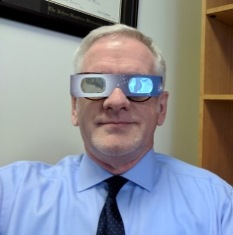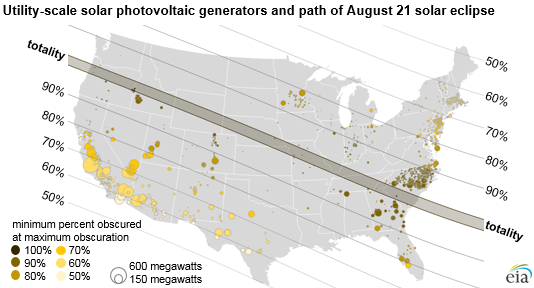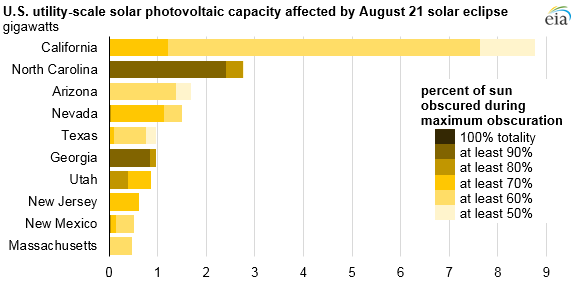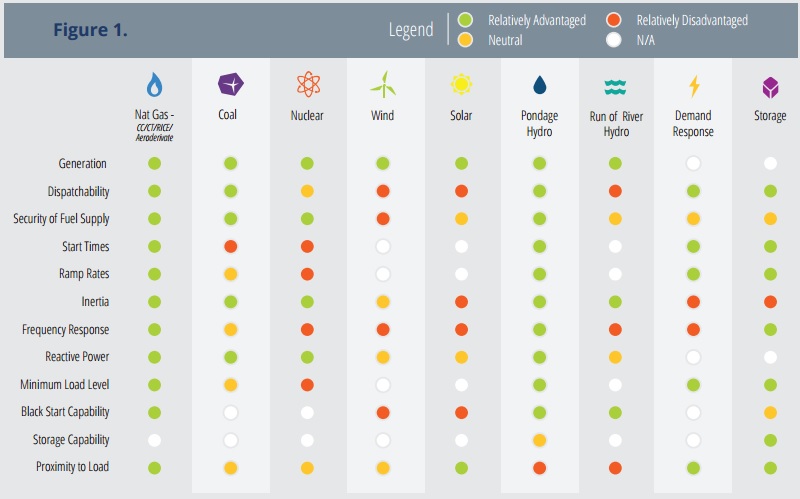Eclipse Mania: Natural Gas Will Shine – As It Always Does
Mark Green
Posted August 17, 2017
 This Monday the moon’s gonna throw some big shade our way. For the first time since 1979, significant parts of the U.S. will experience a total solar eclipse when the moon passes between Earth and the sun. Fasten your chinstraps!
This Monday the moon’s gonna throw some big shade our way. For the first time since 1979, significant parts of the U.S. will experience a total solar eclipse when the moon passes between Earth and the sun. Fasten your chinstraps!
As Eclipse Monday approaches, we’re going eclipse-crazy. There are eclipse websites and eclipse trackers and eclipse apps all over the internet. Eclipse parties are planned. And yes, special eclipse glasses are chic.
The hoopla reminds me of Mark Twain’s “A Connecticut Yankee in King Arthur’s Court,” when the hero, transported back in time, saves himself from harm by claiming he can blot out the sun – knowing there’s an eclipse on that very date in the year 528.

In 2017, it would be hard to find very many people who don’t know about Monday’s big solar outage. Here’s hoping everyone safely enjoys the eclipse in all its wonder – while also absorbing what this dramatic sun interruption teaches about the need for reliable energy in our daily lives.
And that lesson is that natural gas is the every-day essential partner – partner, not backup – to intermittent energy sources like solar because, as will be underscored on Eclipse Monday, the sun doesn’t always shine. Areas that get a lot of their electricity from solar, heads up.
The U.S. Energy Information Administration (EIA) reports that the eclipse will obscure the sunlight needed to generate electricity at about 1,900 utility-scale photovoltaic power plants in the U.S.:

North Carolina and California will be among states most affected, according to EIA:

EIA says solar-powered generators will be affected when the moon totally blocks all direct sunlight for up to three minutes, but they’ll also be affected to a lesser extent throughout the entire eclipse event of up to three hours. EIA:
The path of totality only affects 17 utility-scale solar PV generators, mostly in eastern Oregon. Hundreds of plants totaling about 4.0 gigawatts (GW) of capacity—mostly in North Carolina and Georgia—will be at least 90% obscured. Another 2.2 GW and 3.9 GW of capacity are in areas that will be at least 80% and at least 70% obscured, respectively.
What’ll happen, of course, is that other sources of electricity generation will fill in the void left by solar, such as natural gas, the country’s leading source of net electricity generation in 2016. Natural gas works 24/7/365 – not just on unique days. It’s reliable, responsive and efficient, come rain or shine.
Indeed, natural gas is unique among energy sources in supplying the attributes – capacity, dispatchability, ramp rates and others – needed to ensure the reliability of the U.S. power grid. That’s what a recent study found. Here’s a matrix from that study we posted that shows the ability of various energy sources to support the attributes the grid needs:

Yeah, natural gas works.
The long and the short of it is that natural gas and renewables like solar and wind are partners. Chris Mooney wrote in the Washington Post last year:
We’re at a time of deeply ambitious plans for clean energy growth. Two of the U.S.’s largest states by population, California and New York, have both mandated that power companies get fully 50 percent of their electricity from renewable sources by the year 2030. Only, there’s a problem: Because of the particular nature of clean energy sources like solar and wind, you can’t simply add them to the grid in large volumes and think that’s the end of the story. Rather, because these sources of electricity generation are “intermittent” — solar fluctuates with weather and the daily cycle, wind fluctuates with the wind — there has to be some means of continuing to provide electricity even when they go dark. And the more renewables you have, the bigger this problem can be.
Not a problem if policymakers recognize that natural gas is indispensable to solar and its intermittent buddy, wind. The solar eclipse provides special illumination to the point.
Then there’s this: We know there’ll be an eclipse on Monday; every other day the sun’s intermittency isn’t so predictable. Natural gas and the attributes it brings to the grid – making our lives modern, comfortable and convenient – can be counted on every day and night, eclipse or no eclipse. Something to ponder as we witness Monday’s spectacular light and dark show.
About The Author
Mark Green joined API after a career in newspaper journalism, including 16 years as national editorial writer for The Oklahoman in the paper’s Washington bureau. Previously, Mark was a reporter, copy editor and sports editor at an assortment of newspapers. He earned his journalism degree from the University of Oklahoma and master’s in journalism and public affairs from American University. He and his wife Pamela have two grown children and six grandchildren.


